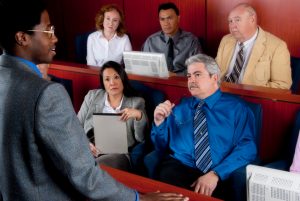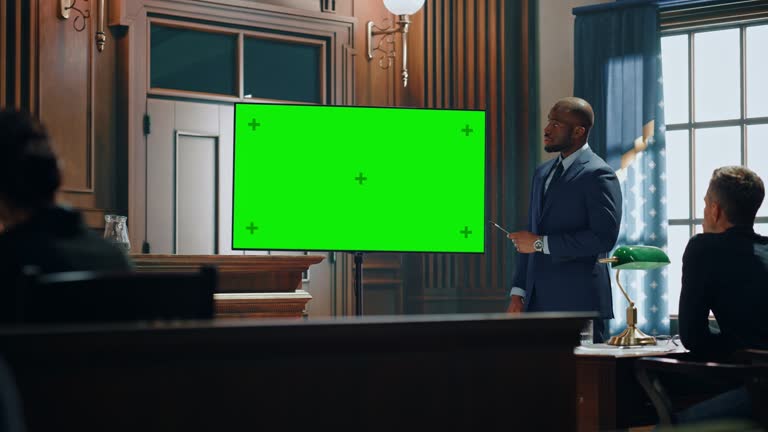The Function of Visual Aids in Effective Trial Presentations: An Overview for Attorneys
The Function of Visual Aids in Effective Trial Presentations: An Overview for Attorneys
Blog Article
Navigating the Complexities of Trial Presentations: Tips for Seamless Distribution and Engaging Disagreements
In the realm of legal process, the art of trial presentation stands as a vital component of success. As lawyers navigate the intricate web of court room dynamics, the capability to flawlessly deliver disagreements and evidence while astounding the jury's attention becomes vital. The intricacies integral in test presentations need a delicate balance of skill, ability, and technique. By developing methods that ensure a polished shipment and crafting engaging arguments that reverberate with the target market, lawyers can dramatically boost their campaigning for. In a world where persuasion reigns supreme, grasping the intricacies of trial presentations is not just an alternative yet a requirement for those seeking to prevail in the courtroom.

Recognizing Trial Goals
To properly navigate a trial, it is vital to have a clear understanding of the objectives that need to be achieved. Prior to tipping into the courtroom, lawful groups need to specify their goals and preferred outcomes. These goals work as assisting concepts throughout the trial, forming methods and influencing decision-making procedures.
Recognizing trial goals entails a thorough evaluation of the situation, legal precedents, and the client's best interests. Trial Presentations. It calls for a careful evaluation of the truths, determining essential concerns, and expecting prospective obstacles. By setting specific and measurable objectives, lawyers can customize their debates and presentations to line up with the preferred outcomes
Moreover, a clear understanding of test objectives enables legal teams to prioritize evidence, witnesses, and lawful arguments effectively. It permits for the advancement of a systematic narrative that reverberates with the discretionary, enhancing the total instance discussion.

Organizing Evidence Properly
Having a clear understanding of test goals lays the structure for arranging proof effectively in legal proceedings. By aligning the presentation of evidence with the wanted results of the test, lawful groups can strengthen their arguments and enhance their persuasiveness.
One more crucial element in arranging proof properly is developing a sensible flow. Offering evidence in a systematic and consecutive fashion can aid develop a compelling narrative that sustains the legal arguments being made. Additionally, making use of aesthetic aids such as timelines, charts, or graphes can even more boost the company of proof and aid in clearing up complicated partnerships or sequences of events.
Furthermore, ensuring that all evidence offered is relevant and acceptable to the instance is vital. Inadmissible or unnecessary evidence can detract from the stamina of the disagreement and possibly damage the reliability of read the full info here the presenting event. For that reason, a precise review and selection process must be carried out to include only one of the most impactful and lawfully sound proof in the trial presentation.
Crafting Influential Narratives
Crafting engaging stories plays a pivotal duty in offering convincing disagreements during lawful process. When constructing a narrative for a test presentation, it is necessary to establish a clear storyline that highlights key factors and connects them in a coherent fashion. By weaving with each other proof, testimony, and legal disagreements into a convincing and natural story, legal professionals can efficiently advocate for their clients and increase the likelihood of a positive result in the court room.
Mastering Aesthetic Help
Efficient use visual aids is essential to boosting the impact and clarity of trial discussions. Aesthetic aids, when made use of tactically, have the power to streamline intricate details, reinforce vital points, and leave a long lasting perception on the court and court. To grasp click here to find out more visual aids in trial presentations, it is vital to make certain that they are clear, succinct, and pertinent to the debates being made.
When incorporating aesthetic aids, such as charts, charts, photos, or timelines, into a test discussion, it is vital to keep them visually appealing yet professional. The visuals must match the spoken arguments, providing a visual depiction of the information being discussed without overwhelming the target market with unneeded information.
In addition, exercising with the aesthetic aids ahead of time is crucial to make certain a smooth shipment throughout the trial. Acquainting oneself with the content, changes, and timings of each visual help can assist keep the flow of the discussion and protect against technological glitches that might develop.
Providing Impactful Closing Disagreements
An engaging closing debate offers as the culmination of a trial discussion, encapsulating the core story and convincing the judge and court towards a favorable choice. Begin by describing the main disagreements that support your client's placement, emphasizing why the evidence presented throughout the test sustains your narrative.
Additionally, incorporating sob story can even more enhance your closing disagreement. By linking and humanizing the instance on a personal degree with the decision-makers, you can evoke compassion and understanding, influencing their perception of the facts presented. In addition, repeating the legal standards that should be satisfied for a positive ruling can reinforce the validity of your position. Eventually, a well-crafted closing argument ought to leave a long lasting impact, engaging the discretionary to regulation in your client's favor.
Conclusion
In conclusion, understanding trial discussions involves comprehending purposes, organizing evidence, crafting narratives, using visual help, and providing impactful closing debates. By applying these methods successfully, lawyers can provide their instance seamlessly and make engaging debates in the courtroom. It is critical to navigate the intricacies of trial discussions with accuracy and skill to achieve success in legal procedures.
By aligning the discussion of proof with the preferred end results of the test, lawful teams can strengthen their disagreements and improve their persuasiveness (Trial Presentations). To understand visual aids in trial presentations, it is essential to make sure that they are clear, succinct, and appropriate to the disagreements being made
A compelling closing debate offers Full Article as the conclusion of a trial presentation, encapsulating the core story and persuading the court and jury towards a favorable decision. Begin by laying out the major debates that support your client's position, highlighting why the proof presented throughout the trial supports your story.In conclusion, grasping test discussions includes understanding goals, arranging proof, crafting stories, using visual help, and supplying impactful closing debates.
Report this page